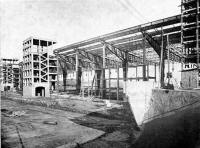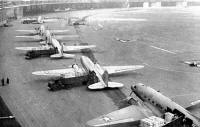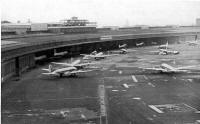From the Files of John & Johanna Lawler (64-66)
From the AF
Pamphlet Entitled"Tempelhof Central Airport
Berlin, Germany"
Tempelhof Central Airport
HISTORY
Tempelhof Central Airport is located in the southern suburbs of Berlin, surrounded by a heavily populated area only two miles from the center of the city. Its history dates back to Frederick William I (1721) when the field was the scene of colorful parades by the Royal Guard Corps.In 1922 Tempelhof was first used as a civilian airport. Not until the latter part of World War II was it used for military operations. In 1934, plans and construction were undertaken for the modern buildings currently in use. These buildings were never completed because of the war.
The arc-shaped steel hangars permit aircraft parking under a roof supported by large beams. The main buildings were first used by the German Reich's chosen instrument, the Deutsche Lufthansa and then as a meteorological school at the beginning of the war.
The entire roof of the hangar, 7/10 of a mile in length, was laid in tiers to form a semicircular stadium designed to seat thousands of spectators for air and ground demonstrations. The roof shows evidence of plans for huge restaurants, public telephones, rest rooms, and numerous facilities for public exhibitions. Tempelhof had its greatest prewar days during 1938-39, when approximately 52 planes arrived daily from other European countries, and 40 German planes operated on a regular basis. During the peak year 247,543 passengers and 7,680 tons of cargo landed at the field.
In 1944 desperate measures were taken by the Germans to build a FW-190 assembly line in the underground corridors. Engines were constructed some distance away and hauled by truck to the base where they were joined to the finished airframes. After a fierce battle with Luftwaffe personnel the Russians took the base in 1945. The German commander, Colonel Rudolph Boettger, killed himself and destroyed important records including the production figures on FW-190's.
Shortly before the occupation of the airport by Americans, the Russians burned large parts of the buildings and opened the base to the general public. As a result, when the Americans moved in on July 2, 1945, they were confronted with many problems due to extensive damage and pilferage. The task of re-establishing the base was assigned to the 483rd Air Services Group, activated 27 May 1945 and consisted of Headquarters, Base Services Squadron, 891st Air Engineering Squadron and 715th Air Material Squadron.
The group was first located at Marienfeld, near Guetersloh, Germany, and was later joined by the 301st Troop Carrier Squadron and a unit of Air Transport Command. The base became known as United States Army Air Force Station Tempelhof. On September 1, 1945, it came under the control of European Air Transport Service and regularly scheduled flights to cities on the continent and England were started.
The name of the base changed on September 19, 1946 to Tempelhof Army Air Base and again on November 9, 1946 to Tempelhof Air Base. On December 20, 1947, operation of the base was transferred from EATS to United States Air Forces in Europe.
As Russian restrictions on land travel became more difficult, Tempelhof activities increased and Berlin began to depend more and more on the Air Force as a means of transportation and for providing essential supplies. On April 1, 1948, USAFE C-47's began a 24 hour schedule between Rhein/Main and Tempelhof. The unofficial blockade was temporarily eased on 6 April as trains and motor vehicles began to move.
The period of relaxed restrictions was brief and on June 20, 1948 around-the-clock flights began once more. "Operation Vittles", later known as Combined Air Lift Task Force, came into existence as the "Berlin Airlift" on 26 June 1948. The airports used were Tempelhof, Gatow and Tegel.
In September and October 1948, two additional runways were constructed at Tempelhof. During the airlift, American and British planes brought in 2,324,257 tons of cargo and flew 109,288,502 miles. Of the total in-bound cargo, 67 per cent was coal, 24 per cent food, and 9 per cent miscellaneous items. During this period, 83,045 tons of cargo were flown out of Berlin. 56,144 British and 37,325 American passengers were flown into the city.
The blockade of Berlin was officially lifted May 12, 1949. In August, the airlift operations began a phase-out period which lasted until the first Airlift Task Force was disbanded on October 1, 1949. The last airlift plane, the 279,114th flight, arrived at Tempelhof at 8:30 p.m., September 30, 1949.
Following the airlift, the 7350th Air Base Group was again reorganized and consolidated into the 7350th Base Complement Squadron. In 1954 it was changed to the 7350th Air Base Squadron. This identity was retained until February 1958 when it became known as the 7350th Support Squadron. On 28 February 1958 Tempelhof Air Base was redesignated as Tempelhof Central Airport. Jan. 1, 1964 the 7350th Support Squadron became the 7350th Support Group directly responsible to Headquarters, USAFE.
MISSION
The primary mission of Tempelhof Central Airport is to provide an aerial port of entry into the divided city of Berlin. As such, TCA is responsible for radar control of all aircraft, including civilian, in the three air corridors between West Berlin and West Germany. Moreover, the personnel of TCA provide support to all Air Force units in Berlin, plus protocol services to a wide variety of visitors.LOCATION OF TEMPELHOF
Tempelhof Central Airport is located in the American Sector of Berlin, approximately two miles south of the heart of the city. The field landing facilities are shared by the United States and West Berlin's civilian airport. Pan American, British European Airways and one Air France cargo flight a day operate from the civilian part of the field.




